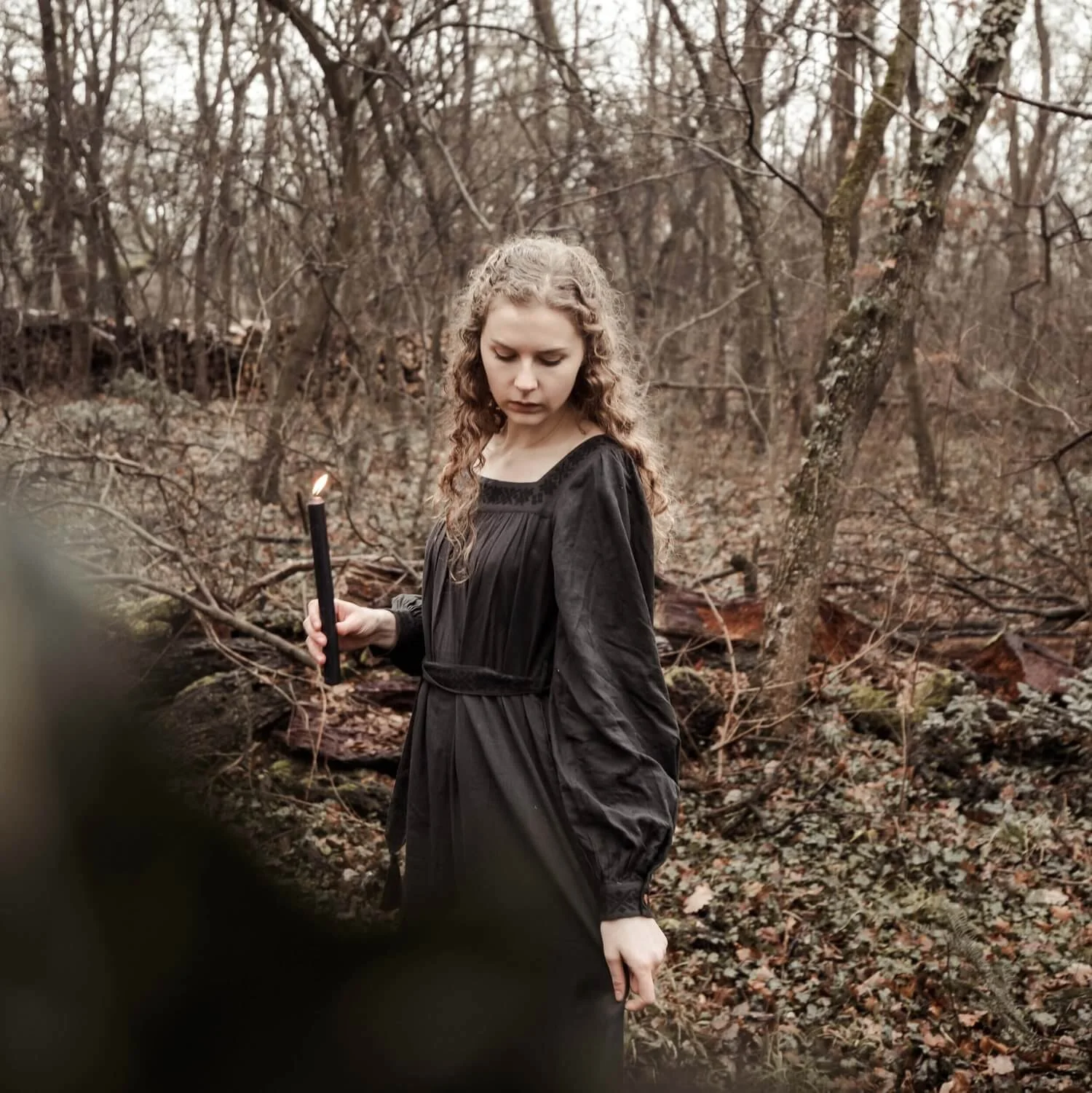The Legend of Saint Winifred
A few years ago, I stumbled on the story of Saint Winifred of Wales—the tale of a young woman and daughter of a Welsh chieftain who lost her life to a jealous lover and, in turn, created a healing spring.
I‘m obsessed with more unknown stories from the early medieval era, particularly when they can be connected with even more ancient sites. That curiosity led me to an unbelievable story of a possibly ancient Celtic goddess who was worshiped in Northern Wales before being co-opted by the Catholic church.
Let’s follow the clues to unearth the mystery of this potential Celtic goddess.
Who is Saint Winifred?
Saint Winifred, also known by her Welsh name Gwenfewi or Gwenfrewy, is a well-known Welsh figure wrapped up in mystery and legend. The daughter of a well-regarded Welsh chieftain, she was brought to her untimely death at the hands of a jealous suitor.
The oldest surviving account of Saint Winifred and her life comes from Robert Pennant the Prior of Shrewsbury in the 12th century, in an attempt to popularize her story and relics, which were then housed at the cathedral, to draw in more pilgrims and donations.
As Winifred‘s popularity grew, more mentions of her were noted down by religious scholars. Cardinal Baronius, an Italian orator and historian, recorded her life in Roman Matyrology in 1584, many years after her supposed death in 650 AD.
At the height of Winifred‘s fame from the 11th century until the 16th century, pilgrims would travel from across England to visit her healing well in North Wales. Winifred also appears in the legendary tale, Sir Gawain and the Green Knight, a 14th-century chivalric romance tale, where Sir Gawain meets the ghost of Winifred and is asked to help her retrieve her head from the well.
The story of Saint Winifred
Saint Winifred‘s story begins in North-East Wales, named Tegeingl in Welsh, deriving from the ancient name Deceangli, a Celtic tribe that inhabited the region since the 1st century BC.
A map of the Celtic tribes of Wales.
Winifred was the daughter of the chieftain Tyfid ap Eiludd and a woman named Wenlo, said to be the niece of Saint Beuno, a 7th-century Welsh Abbott. Winifred was the only daughter of the couple and, being a noble woman, was afforded the luxury of being educated.
When Winifred became of age to marry, her father sought a suitor to give him an heir. Without wasting any time, he arranged for her to be betrothed by a local chieftain, Caradoc or Caradog, meaning "lover" in Welsh.
Winifred was witty and, by all accounts, had no interest in being married off. So, she told Caradoc that she was already engaged to another man and fled to Beuno‘s oratory.
As she was fleeing, Caradoc, enraged by her rebuffing of his romantic advances, came up behind her on his horse and cleaved her head from her body. Beuno is said to have heard the commotion and run out of the oratory to curse Caradoc for his actions, turning him to melted wax.
Saint Winifred in medieval art.
Beuno fell to his knees beside the body of his beloved niece. He gathered up her head and placed it onto her body once more, praying over her remains for a miracle. It’s said that her soul returned to her body, and only a thin line around her neck showed the horrors she was subjected to.
It is said that before Saint Beuno left the spot, he seated himself on a stone by a pool and promised in the name of God that “whoever on that spot should ask a benefit from God in the name of Saint Winifrede would obtain the grace he asked if it was for the good of his soul.”
Winifred, alive once again, became the Abbess of the oratory and recruited 11 other virgins as her nuns. Later, she was said to have joined the nunnery at Gwytherin and died 15 years later. Her relics were enshrined at Gwytherin, later transferred to Shrewsbury Abbey in 1138.
In another version of the legend, Winifred‘s head was said to have rolled down a hill, where it abruptly stopped and a spring erupted from the ground, providing anyone who bathed in it with healing. Her blood permanently stained the rocks a bright red, a reminder of her sacrifice.
Saint Winifred‘s Well
In Holywell, Flintshire, Saint Winifred‘s well stands tall and imposing against the Welsh landscape. The location of the well, Holywell, or Trefynnon in Welsh translates to "town of the well" showing how important the site was. It‘s believed that the local people of the area worshiped her as early as the 8th century, however, she was not well known outside of the community at that time.
Saint Winifred‘s Well in Flintshire, Wales.
The water at Saint Winifred‘s well gushes out into the pool below, spurting out 22.5 tonnes of water per minute. The keepers of the well even had to place stones over the spring to stop it from turning into a spurting fountain. It‘s almost as if ancient people equated the force of the water‘s flow to the speed of the blood spurting out of Winifred‘s neck when Caradoc decapitated her.
The legend of Winifred‘s story also mentions the red-stained rocks around the well as a symbol of her blood. Interestingly, the stones around the well in times past were stained red from a special red algae. Medieval pilgrims would scrape a part of the red moss off as a souvenir, leading the keepers of the well to replenish the algae daily from a nearby hill.
The chapel above the well was built in the late 15th century, which begs the question: what was there before? Is there any evidence that Holywell was an ancient site?
Interestingly, archaeologists, when surveying the area around Holywell, found evidence of an Iron Age settlement some 2000 years ago. Roman round houses, coins, and a triskele artifact were found, along with evidence of former Roman sites such as forts, baths, and other settlement locations. Down the road at Rhosesmor, archaeologists discovered Welsh timber longhouses dating to the 3rd millennium BC—the earliest human settlement known in the area.
Saint Winifred‘s Church at Gwyrtherin
In the small town of Gwyrtherin, Conwy, Wales, an old church dedicated to Saint Winifred stands only 45 km from Winifred‘s Well. Winifred‘s remains were kept at the Gwyrtherin church until they were taken to Shrewsbury in 1138. The church that remains today dates to the 19th century, but historians and archaeologists have found that the site itself is much older.
Distance from Holywell to Winifred‘s church in Gwytherin, Clwyd.
Archaeologists found Romano-British inscriptions on the earliest placed stones in the church, suggesting that worship in this area had continued from around the 5th or 6th century.
Historians suggest that since the stones with inscriptions were found at the back of the church, it could indicate an earlier burial mound, making the church the site of Saint Winifred‘s ancestral grave.
The old yew trees and graveyard around St Winifred‘s church in Gwytherin, Clwyd.
The church is built on top of a naturally occurring mound that leads down to a natural ditch where today a cemetery still functions. Around the site, ancient yew trees stand in an organized circle. Experts agree that the yews, perhaps around 2500-3000 years old, denote an ancient sacred gathering place to celebrate the dead.
In the story, it‘s said that Winifred travelled to the church in Gwyrtherin with 11 of her virgin disciples. Interestingly, experts found all three of the remaining trees around the church to be female—if more trees did exist at one point, perhaps these yews could be the 11 disciples.
All of these findings around Saint Winifred‘s church lend more credence to Winifred being an old Celtic goddess.
The Cult of Saint Winifred
Saint Winifred‘s tale is filled with Celtic motifs, symbols, and references to the natural landscape. The water spurting forth like blood, the red algae that lined the stones, and the mystery of both the well and the church that bears her name.
Saint Winifred‘s healing waters in Holywell, Wales.
Historians believe that Saint Winifred‘s legend can be traced back further than its early medieval records, suggesting the version of the story we have today is highly Christianized, trying to obscure her pagan origins. Perhaps there was a Cult of Winifred.
The way that Winifred dies can even be traced to many other well-known pagan legends about a maiden being killed by a lustful man, where a spring gushes forth on the spot. In Celtic mythology, the head was said to be the seat of the soul.
“A maiden is chased down by a pursuer who succeeds in deflowering and killing her...a spring gushes forth on the spot to signify the natural restoration of her maidenhead (virginity), rather than her natural head.”
Instead of Winifred being the niece of a famous Welsh abbot, she was likely a whisper of an old pagan tale that aimed to connect virginity, sexual rituals, healing water, and nature. Winifred gave her life to cleanse the land and provide healing water to those who were in need.
Her story reminds me of many other Celtic tales about women and water, like the goddess Boann who summoned the great Boyne river, or Sabrina who gave her life to the River Severn.
What happened to Saint Winifred?
The amazing archaeology studies into Saint Winifred‘s life and sacred locations points to her being a more ancient Celtic goddess. Like other local water goddesses, Winifred must have been a healing figure, associated with the natural springs around the area.
Associated with fertility and virginity, and the blood of her slaying, her story fit into Celtic literature archetypes of the time. Her noble origins, as a daughter of a local chieftain, could have been a later addition as a way for lineages of local chieftains to assert their dominance.
Over time, Winifred‘s story was co-opted by the Catholic church to gain a foothold in the area and convert pagans to Christians.
The most interesting part of Winifred‘s legacy for me is the church built upon an old hill, surrounded by a circle of cultivated yews and standing stones. We may never know what rituals were performed to call to Winifred, but we do have the remains of a once great place of Celtic worship.







Saint Winifred‘s mythology and history go back further than her medieval tale.